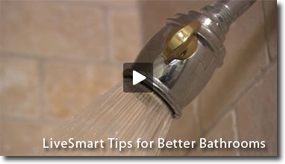In B.C., measures implemented by local governments – like conservation planning, water metering, green buildings, and water efficiency requirements in plumbing codes – show how successfully we can cut our water use, energy bills, and help the environment.
The Living Water Smart implementation team produced a self-guided Home Water Assessment to assess residential water use and behaviour. The Home Water Assessment was included with LiveSmart BC’s home energy assessment, which was undertaken in 40,000 homes. Many British Columbians have shared their stories and ideas about reducing water use in their homes.
Requiring water-conserving plumbing fixtures such as low flush toilets
Making new, inexpensive technology such as readily available high efficiency and dual flush toilets mandatory in new homes and renovations makes reducing our water use easy, and decreases demand for treated potable water.
Effective October 3, 2011, the BC Building Code regulation requires the installation of high-efficiency toilets and urinals in all new residential buildings and renovation projects involving toilet replacements in British Columbia.
Mandating purple pipes for water collection and reuse
Reusing water means we can save the best water for drinking and take less from the environment. There are many ways to reuse water. One way is to capture rainwater and reuse it for watering gardens. Another way is to install a non-potable water system that recycles water from clothes washing, bathroom sinks and showers and uses it for flushing toilets or landscape irrigation. This reused water is contained in a second set of plumbing pipes that are coloured purple to differentiate it from potable water.
- The 2012 BC Codes includes new provisions to enable non-potable water use for certain plumbing fixtures and underground irrigation systems.
Labelling efficient water consuming products
When it comes to water efficiency, not all technology is the same. For example, top loading washing machines (clothing) use much more water than comparably priced front loading machines. Water efficiency labelling provides consumer information on water consumption and the relative efficiency of a product.
In October 2011, the BC Ministry of Environment became a Promotional Partner of the US Environmental Protection Agency (EPA) WaterSense Program. Similar to the Energy Star labelling program for energy consumption, WaterSense labels can be placed on products that have been independently certified as meeting EPA water efficiency and performance criteria.


